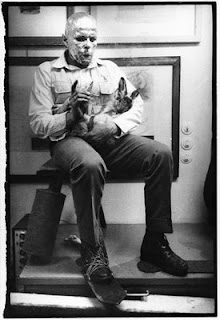Joseph Beuys
Joseph Beuys- 1980 |
When i think of Beuys, I think of two things: the theoretical endeavours of “social sculpture,” and his statement “everybody is an artist ” He played the role of many: Artist, political activist, withdrawn introvert and fighter for environmental causes. In the mid-60s, Beuys worked with the avant-garde art group known as Fluxus.
It was during this period that he began to stage "actions," where he would perform works in a ritualistic way. One of the best known of these was How to Explain Pictures to a Dead Hare from 1965. Beuys covered his head with honey and gold leaf, wore one shoe with felt on its sole, another soled with iron. He transformed himself into a sculpture.
He said, he took the hare ''to the pictures and I explained to him everything that was to be seen. I let him touch the pictures with his paws and meanwhile talked to him about them....I explained them to him because I do not really like explaining them to people. Of course there is a shadow of truth in this. A hare comprehends more than many human beings with their stubborn rationalism....I told him that he needed only to scan the picture to understand what is really important about it. The hare probably knows better than man that directions are important. You know the hare can turn on a dime. And actually nothing else is involved."
Joseph Beuys- How to explain pictures to dead hares. |
He walked through an art gallery for two hours, explaining the art hanging there to a dead hare that he carried. This reminds me of role that could be played in a Tim Burton film. Theoretical, eccentric and crazy act of self indulgence.
Beuys' better known works are Felt Suit (1970), a felt suit exhibited on a coat hanger; the performance piece Coyote, "I Like America and America Likes Me" (1974) (image below) for which Beuys wrapped himself in felt and stayed in a room with a coyote for five days. For Native Americans, the coyote had been a powerful god, with the power to move between the physical and the spiritual world. After the coming of European settlers, it was seen merely as a pest, to be exterminated. Beuys saw the debasement of the coyote as a symbol of the damage done by white men to the American continent and its native cultures. His action was an attempt to heal some of those wounds. ‘You could say that a reckoning has to be made with the coyote, and only then can this trauma be lifted’, he said. In the sculpture Fat Corner, Beuys piled fat into the corner of a space, left to melt and turn rancid over a number of days. In the video below he shows us how his fascination with fat has unveiled in many of his exhibitions.
Fat Chair, Beuys-1964 |
'The Temptation of the 21st Century'- Beuys |
'I like America and America likes me'- Beuys, Installation, 1974 |
The connection between art and the natural sciences, between art and medicine was something that Beuys discovered by looking at Leonardo Da Vinci. He conducted research into nature and explored the topic of healing in his works like no other artist. Many of his works, drawings, actions and lectures contained motifs and allusions from the worlds of healing and medicine.In his final creative period, the artist devoted much thought to shamanism, which for him was a natural philosophy which invoked a primordial world where all being lived in harmony.





No comments:
Post a Comment